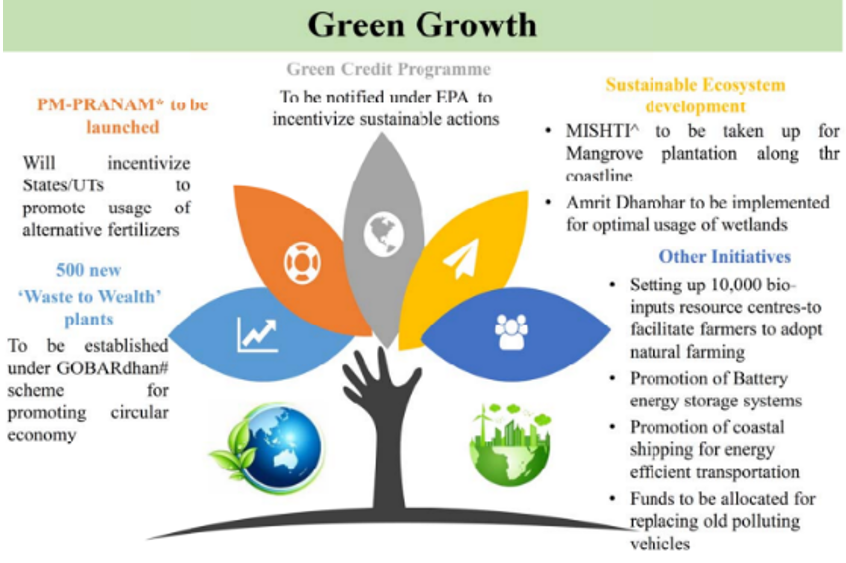Introduction
The seven “Saptarishi” priorities-inclusive development, reaching the last mile, infrastructure and investment, unleashing the potential, youth power, the financial sector, and green growth, are the major themes of the Union Budget, 2023. In her budget speech, the Finance Minister emphasized the words “green” and “sustainable” numerous times. She suggested that during Amrit Kaal, green growth might be revolutionary. The fundamental objective of green growth strategies is to make sure that natural resources can sustainably fulfil their maximum economic potential.
Furthermore, the Budget highlights the following four revolutionary opportunities in order to achieve India@100:
- Economic Empowerment of Women through Self Help Groups
- PM VIshwakarma KAushal Samman (PM VIKAS)
- Tourism Promotion in Mission Mode
- Green Growth
What is Green Growth?
In essence, ‘Green Growth’ refers to an economic growth plan that places a significant emphasis on sustainable development while minimizing harmful environmental effects. Out of 180 countries, India was placed 169th in the Environment Performance Index of 2022. Rankings were determined by factors like waste management, air quality, biodiversity & habitat, fisheries, ecosystem services, and climate change. India is the fifth-largest economy in the world, although it performed worse than many other smaller economies on the ranking.
India’s Initiative to Promote Green Growth:
The vision for “LiFE,” or Lifestyle for Environment, set forward by the prime minister aims to inspire a trend towards living sustainably. To lead the world into a green industrial and economic transition, India is vigorously pursuing the “panchamrit” and net-zero carbon emissions by 2070.
Additionally, India is putting into practice numerous policies and programmes for the effective use of energy across various economic sectors, including green buildings, green equipment, green farming, green mobility, and green fuels. Large-scale green job opportunities are facilitated by these green growth initiatives, which also contribute in diminishing the economy’s carbon intensity.

Source: https://www.indiabudget.gov.in/doc/bh1.pdf
Proposed Initiatives in Brief:
- National Green Hydrogen Mission:
- A budget of Rs 19,700 crores has been set aside for the National Green Hydrogen Mission in order to support the transition of the economy to low carbon intensity, lessen reliance on fossil fuel imports, and enable the nation to assume technological and market leadership in this emerging industry.
- By 2030, a production of 5 MMT per year is the goal
- GOBARdhan Scheme:
- 500 new “waste to wealth” plants (200 compressed biogas (CBG) plants and 300 community/cluster-based plants) will be built as part of the GOBARdhan Scheme to support the circular economy. 10,000 crores were invested in total.
- In due course, a 5% CBG mandate will be introduced for all organizations marketing natural and biogas.
- Bhartiya Prakritik Kheti Bio-Input Resource Centers:
- Over the course of the next three years, the Center will help 1 crore farmers transition to natural farming by establishing 10,000 Bio-Input Resource Centers, establishing a distributed national network for the production of micro-fertilizers and pesticides.
- MISHTI:
- The MISHTI (Mangrove Initiative for Shoreline Habitats & Tangible Incomes), which will be run by combining resources from MGNREGS, Campa Fund, and other sources, will revolutionize mangrove protection.
- MISHTI will help with mangrove planting on saltpan areas and along India’s coastline.
- PM PRANAM:
- “Prime Minister Programme for Restoration, Awareness, Nourishment, and Amelioration of Mother Earth”, through this program, states and union territories will be encouraged to promote the balanced use of chemical fertilizers as well as alternative fertilizers.
- Amrit Dharohar:
- Union Budget for 2023–24 announced the Amrit Dharohar programme, a central government initiative to protect wetlands.
- Over the following three years, Amrit Dharohar will be put into practice to promote the best possible use of wetlands, and improve biodiversity, carbon stocks, ecotourism prospects, and revenue production for nearby communities.
- Other Investments in Green Energy:
- Rs. 35,000 crores for priority capital investments towards energy transition and net zero objectives which basically leads to cutting greenhouse gas emissions to as close to zero as possible, with any remaining emissions re-absorbed from the atmosphere, by oceans and forests for instance, as well as energy security (Ministry of Petroleum & Natural Gas).
- Battery Energy Storage Systems with a 4,000 MWH capacity will receive viability gap funding that is designed to provide capital support to PPP (Public Private Partnership) projects which would not otherwise be financially viable.
- Rs 20,700 crore (central support – Rs 8,300 crore) for inter-state transmission system for evacuation and grid integration of 13 GW renewable energy from Ladakh.
Conclusion
The ongoing depletion is negatively affecting both the environment and the country’s economy. In the trajectory of India’s expected expansion, environmental sustainability has proven to be a significant problem. Therefore, the focus of Budget 2023 is on the nation’s efforts to achieve economic development while also safeguarding the environment and natural resources for future generations. This entails encouraging renewable energy, lowering pollution, enhancing waste management, and protecting biodiversity. In India, green growth aims to promote sustainable development and strike a balance between economic growth and environmental conservation.
Disclaimer
The information provided in this article is intended for general informational purposes only and should not be construed as legal advice. The content of this article is not intended to create and receipt of it does not constitute any relationship. Readers should not act upon this information without seeking professional legal counsel.


